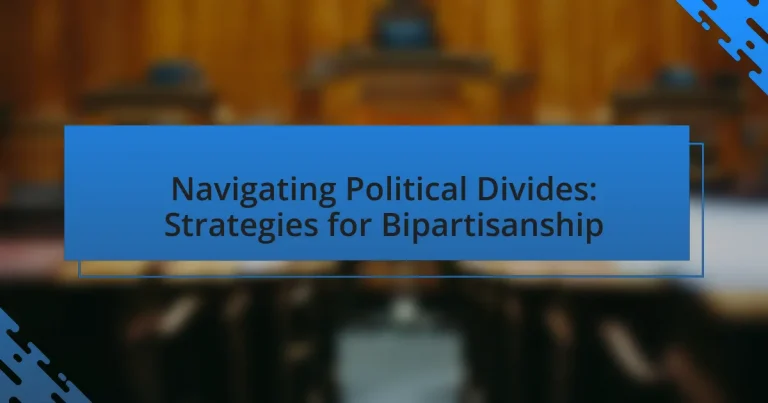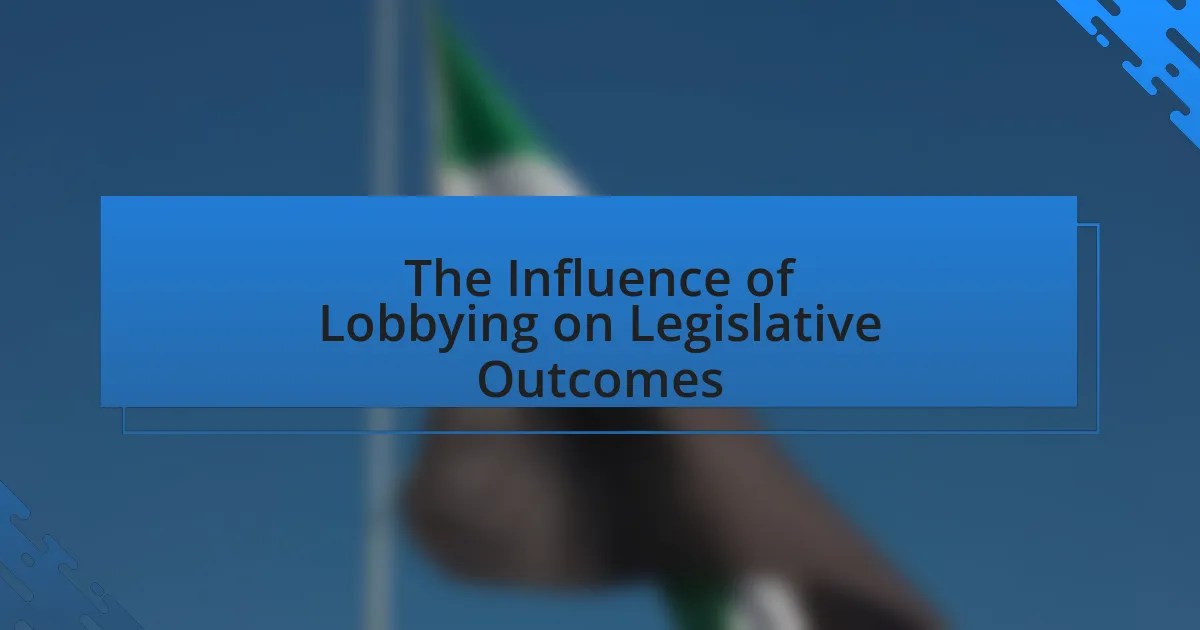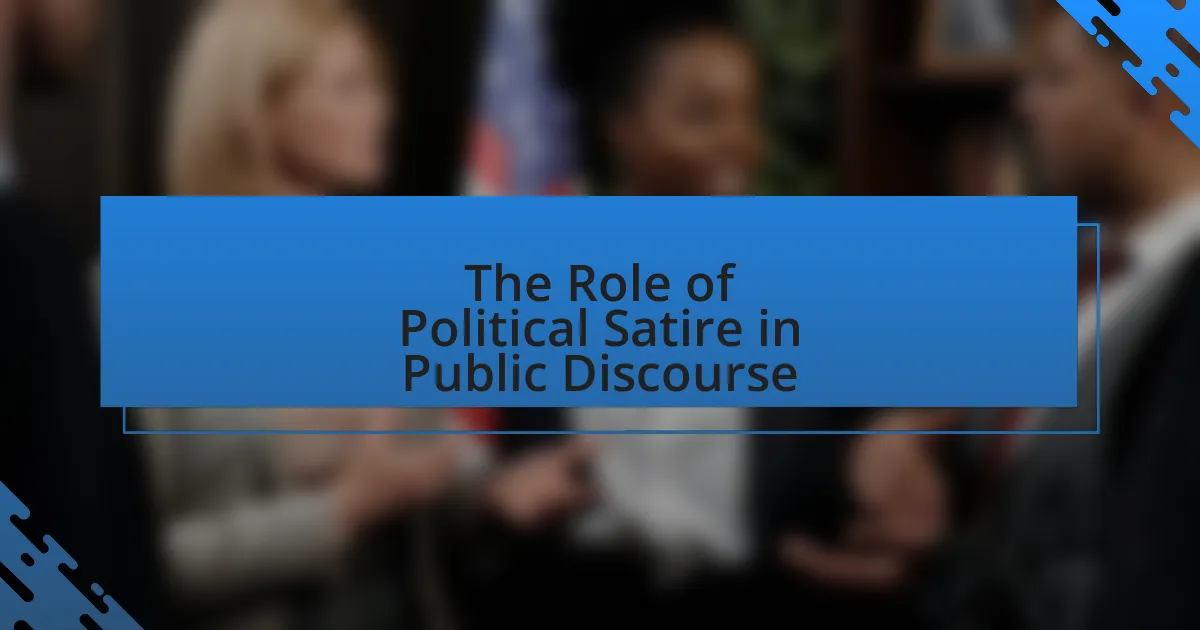The article “Navigating Political Divides: Strategies for Bipartisanship” examines the challenges posed by entrenched ideological differences, misinformation, and a lack of trust among political factions. It explores how these divides manifest in society, the historical roots of current polarization, and the role of media and social platforms in exacerbating these issues. The importance of bipartisanship for effective governance is emphasized, along with strategies to foster collaboration, such as open dialogue and community involvement. Additionally, the article highlights successful collaborative initiatives and resources available for understanding and promoting bipartisanship.
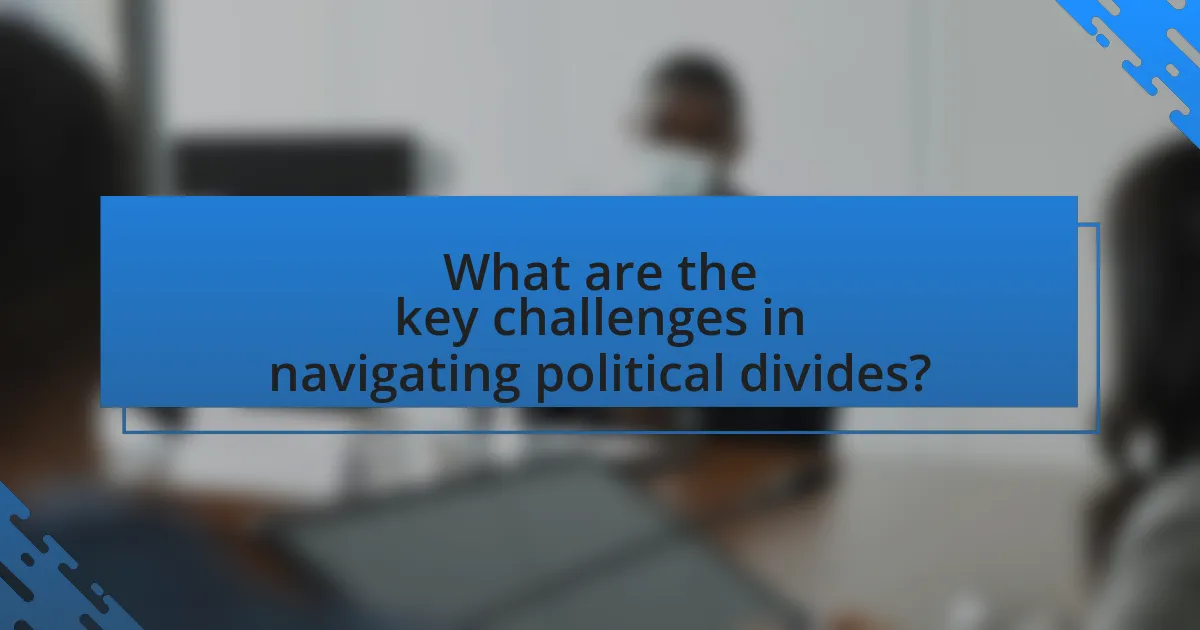
What are the key challenges in navigating political divides?
The key challenges in navigating political divides include entrenched ideological differences, misinformation, and lack of trust among opposing groups. Entrenched ideological differences create barriers to compromise, as individuals often prioritize party loyalty over collaborative solutions. Misinformation exacerbates these divides by distorting facts and fostering polarization, making it difficult for individuals to engage in constructive dialogue. Additionally, a lack of trust between political factions hinders cooperation, as past grievances and perceived betrayals lead to skepticism about the intentions of the opposing side. These challenges are supported by studies indicating that polarization has increased significantly in recent years, with a 2020 Pew Research Center report highlighting that 77% of Americans view the opposing party as a threat to the nation’s well-being.
How do political divides manifest in society?
Political divides manifest in society through polarization, which is evident in differing opinions on social issues, economic policies, and governance. This polarization often leads to the formation of echo chambers, where individuals only engage with like-minded perspectives, reinforcing their beliefs. For instance, surveys indicate that in the United States, political affiliation significantly influences social interactions, with many individuals reporting discomfort in friendships with those from opposing political parties. Additionally, political divides can result in increased hostility and conflict, as seen in protests and public demonstrations that often reflect deep-seated ideological differences. These manifestations highlight the challenges of achieving bipartisanship in a fragmented political landscape.
What are the historical roots of current political divides?
The historical roots of current political divides stem from longstanding ideological, economic, and social conflicts that have evolved over time. For instance, the American Civil War (1861-1865) created deep divisions between the North and South, primarily over issues of slavery and states’ rights, which continue to influence regional political identities today. Additionally, the New Deal era in the 1930s reshaped political alignments, as the Democratic Party became associated with government intervention in the economy, contrasting with the Republican emphasis on limited government. These historical events laid the groundwork for contemporary partisan divides, as differing values regarding government roles, economic policies, and social issues have persisted and intensified over the decades.
How do media and social platforms influence political divides?
Media and social platforms significantly influence political divides by shaping public perception and facilitating echo chambers. These platforms curate content based on user preferences, often amplifying partisan viewpoints while minimizing exposure to opposing perspectives. Research from the Pew Research Center indicates that individuals who primarily consume news from social media are more likely to hold polarized views, as algorithms prioritize engagement over balanced information. This selective exposure fosters an environment where misinformation can thrive, further entrenching divisions. Additionally, studies show that social media interactions can reinforce group identity, leading to increased hostility toward opposing political groups.
Why is bipartisanship important in a divided political landscape?
Bipartisanship is important in a divided political landscape because it fosters collaboration and compromise between opposing political parties, leading to more effective governance. When parties work together, they can create policies that reflect a broader range of perspectives, which enhances the legitimacy and acceptance of legislation among the public. Historical examples, such as the passage of the Affordable Care Act in 2010, demonstrate that bipartisan support can lead to significant reforms that address pressing societal issues. Additionally, research from the Pew Research Center indicates that bipartisan cooperation can reduce political polarization, ultimately contributing to a more stable and functional political environment.
What are the potential consequences of failing to achieve bipartisanship?
Failing to achieve bipartisanship can lead to legislative gridlock, where essential policies and reforms are stalled due to partisan conflicts. This stagnation can result in a lack of progress on critical issues such as healthcare, infrastructure, and climate change, ultimately affecting the well-being of citizens. Historical examples, such as the inability to pass comprehensive immigration reform in the U.S. Congress, illustrate how partisan divisions can prevent necessary action, leaving pressing problems unresolved and eroding public trust in government institutions.
How can bipartisanship lead to more effective governance?
Bipartisanship can lead to more effective governance by fostering collaboration between political parties, which enhances the likelihood of passing legislation that addresses a broader range of public concerns. When both parties work together, they can combine diverse perspectives and expertise, leading to more comprehensive and balanced policy solutions. Historical examples, such as the passage of the Affordable Care Act in 2010, demonstrate that bipartisan support can result in more sustainable and widely accepted policies, as they reflect a consensus rather than a unilateral approach. Additionally, research from the Pew Research Center indicates that bipartisan cooperation can improve public trust in government, as citizens perceive a commitment to addressing issues collaboratively rather than through partisan conflict.

What strategies can be employed to foster bipartisanship?
To foster bipartisanship, strategies such as promoting open dialogue, establishing common goals, and encouraging collaborative policymaking can be employed. Open dialogue allows representatives from different parties to communicate effectively, reducing misunderstandings and building trust. Establishing common goals, such as addressing public health or economic recovery, creates a shared purpose that transcends party lines. Collaborative policymaking, which involves joint committees and bipartisan initiatives, ensures that diverse perspectives are included in the legislative process, leading to more comprehensive solutions. Historical examples, such as the bipartisan support for the Americans with Disabilities Act in 1990, demonstrate that when parties work together towards a common objective, significant progress can be achieved.
How can dialogue and communication bridge political divides?
Dialogue and communication can bridge political divides by fostering understanding and empathy among differing viewpoints. Engaging in open conversations allows individuals to express their perspectives, which can lead to the identification of common ground. Research indicates that when people engage in dialogue, they are more likely to develop a sense of trust and reduce hostility, as seen in studies conducted by the National Institute for Civil Discourse, which found that structured dialogues can significantly decrease polarization. Furthermore, effective communication strategies, such as active listening and reframing contentious issues, can facilitate constructive discussions, ultimately promoting collaboration and bipartisanship.
What role do town hall meetings play in promoting bipartisanship?
Town hall meetings serve as a crucial platform for promoting bipartisanship by facilitating direct communication between constituents and elected officials. These gatherings encourage open dialogue, allowing individuals from diverse political backgrounds to express their views and concerns in a shared space. Research indicates that when constituents engage in face-to-face discussions, it fosters understanding and reduces polarization, as evidenced by a study from the National Institute for Civil Discourse, which found that 70% of participants felt more empathetic towards opposing viewpoints after attending such meetings. This interaction not only humanizes political discourse but also encourages collaboration among lawmakers, as they are more likely to address issues that resonate with a broader audience, thereby enhancing bipartisan efforts.
How can active listening improve political discussions?
Active listening can significantly improve political discussions by fostering mutual understanding and reducing conflict. When participants engage in active listening, they demonstrate respect for differing viewpoints, which encourages open dialogue. Research indicates that active listening techniques, such as paraphrasing and asking clarifying questions, can lead to more constructive conversations and a greater willingness to find common ground. For example, a study published in the Journal of Conflict Resolution found that active listening in negotiations resulted in higher satisfaction and better outcomes for all parties involved. This approach not only enhances the quality of discussions but also promotes a collaborative atmosphere essential for effective bipartisanship.
What collaborative initiatives have proven successful in the past?
Collaborative initiatives that have proven successful in the past include the bipartisan efforts of the National Commission on Fiscal Responsibility and Reform, also known as the Simpson-Bowles Commission, which aimed to address the national debt through a combination of spending cuts and tax reforms. This initiative gained traction due to its inclusive approach, bringing together members from both major political parties to discuss and propose solutions. Additionally, the bipartisan infrastructure bill passed in 2021, which allocated $1.2 trillion for infrastructure improvements, demonstrated effective collaboration between Democrats and Republicans, showcasing a shared commitment to enhancing national infrastructure while addressing economic recovery post-pandemic. These examples illustrate that successful collaboration often hinges on shared goals and the willingness to engage in constructive dialogue across party lines.
Which bipartisan organizations are leading the way in collaboration?
The bipartisan organizations leading the way in collaboration include the Bipartisan Policy Center, No Labels, and the Problem Solvers Caucus. The Bipartisan Policy Center focuses on developing and promoting policy solutions that require cooperation across party lines, evidenced by its work on issues like immigration reform and healthcare. No Labels aims to foster bipartisan cooperation in Congress, advocating for a centrist approach to governance. The Problem Solvers Caucus, composed of an equal number of Democrats and Republicans, works to find common ground on legislative issues, demonstrating its effectiveness through successful bipartisan initiatives.
How can cross-party alliances be formed effectively?
Cross-party alliances can be formed effectively by establishing common goals and fostering open communication between parties. Identifying shared interests, such as economic reform or social issues, allows parties to unite around specific objectives. For instance, the bipartisan efforts in the U.S. Congress on criminal justice reform demonstrate how collaboration can lead to successful legislation when both parties prioritize a common cause. Additionally, regular dialogue and negotiation help build trust and understanding, which are essential for sustaining these alliances. Historical examples, such as the passage of the Affordable Care Act, show that effective cross-party collaboration often involves compromise and a willingness to address the concerns of all stakeholders involved.
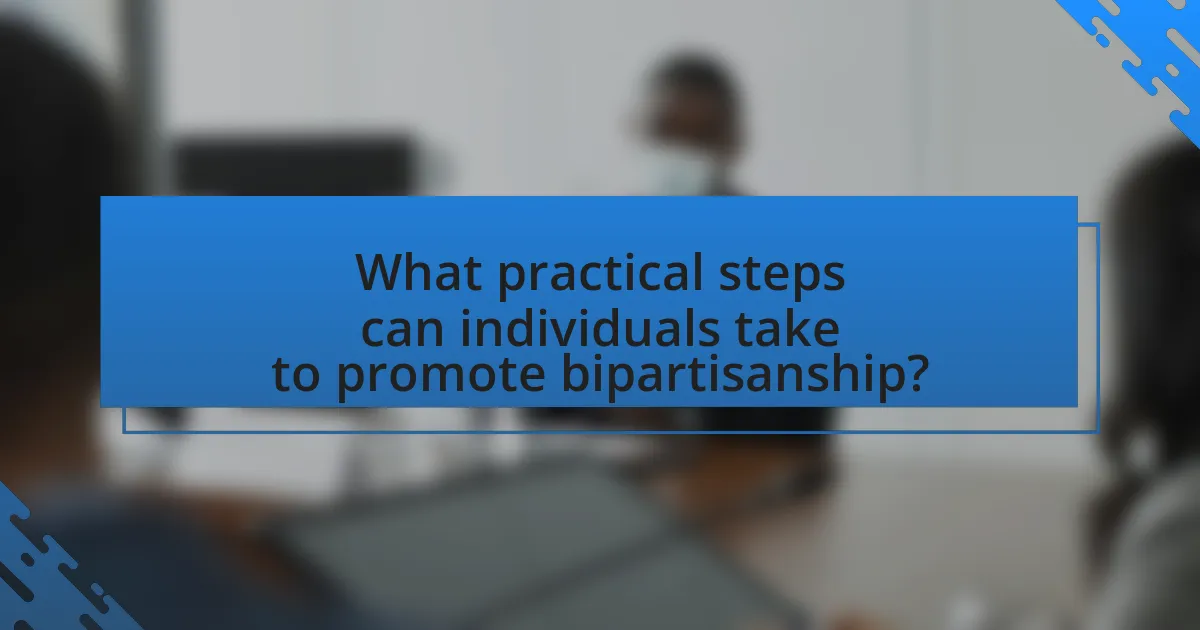
What practical steps can individuals take to promote bipartisanship?
Individuals can promote bipartisanship by engaging in open dialogue with people holding differing political views. This involves actively listening to opposing perspectives, which fosters understanding and reduces polarization. Research indicates that personal interactions across party lines can significantly decrease biases and promote cooperative behavior, as shown in studies by the National Institute for Civil Discourse. Additionally, individuals can participate in community forums that encourage bipartisan discussions, thereby creating a platform for shared solutions to common issues. Engaging in volunteer work with diverse groups also helps build relationships that transcend political affiliations, reinforcing the idea that collaboration is possible despite differences.
How can citizens engage in constructive political discourse?
Citizens can engage in constructive political discourse by actively listening to differing viewpoints and fostering respectful dialogue. This approach encourages understanding and reduces polarization, as evidenced by studies showing that individuals who engage in open conversations with those holding opposing views are more likely to find common ground. For instance, research from the University of California, Berkeley, highlights that structured dialogues can lead to increased empathy and reduced hostility among participants. By prioritizing empathy and respect, citizens can contribute to a more productive political environment.
What techniques can individuals use to remain open-minded in discussions?
Individuals can remain open-minded in discussions by actively practicing empathetic listening, which involves fully concentrating on the speaker, understanding their perspective, and responding thoughtfully. This technique fosters a respectful dialogue and encourages the exchange of diverse viewpoints. Research indicates that empathetic listening can reduce conflict and enhance mutual understanding, as demonstrated in a study published in the Journal of Conflict Resolution, where participants who engaged in empathetic listening reported higher levels of satisfaction in discussions and a greater willingness to consider opposing viewpoints.
How can community involvement enhance bipartisanship efforts?
Community involvement can enhance bipartisanship efforts by fostering dialogue and collaboration among diverse political groups. When community members engage in local initiatives, they create opportunities for individuals from different political backgrounds to work together towards common goals, such as improving public services or addressing social issues. This collaborative environment encourages understanding and reduces polarization, as evidenced by studies showing that shared community projects can lead to increased trust and cooperation among participants with differing political views. For instance, initiatives like community clean-up days or local town hall meetings have historically brought together citizens from various political affiliations, resulting in more constructive discussions and joint problem-solving efforts.
What resources are available for those seeking to understand bipartisanship better?
Resources available for understanding bipartisanship include books, academic articles, and online platforms. Notable books such as “The Bipartisan Policy Center’s Guide to Bipartisanship” provide insights into collaborative governance. Academic articles from journals like the “Journal of Politics” explore case studies and theoretical frameworks on bipartisan efforts. Online platforms, including the Bipartisan Policy Center’s website, offer reports, webinars, and policy analysis that enhance understanding of bipartisan strategies and their implementation in contemporary politics. These resources collectively contribute to a comprehensive understanding of bipartisanship.
Which books and articles provide insights into successful bipartisanship strategies?
Books and articles that provide insights into successful bipartisanship strategies include “The Bipartisan Policy Center’s Report on Bipartisanship” which outlines effective collaboration techniques among political parties. Additionally, “The New York Times” article “How to Make Bipartisanship Work” discusses practical approaches to fostering cooperation in a divided political landscape. Another significant resource is “The Politics of Bipartisanship” by Thomas E. Mann and Norman J. Ornstein, which analyzes historical examples and offers strategies for achieving bipartisan agreements. These sources collectively emphasize the importance of dialogue, compromise, and understanding differing perspectives in political negotiations.
How can online platforms facilitate bipartisan discussions?
Online platforms can facilitate bipartisan discussions by providing neutral spaces for dialogue and promoting diverse viewpoints. These platforms can implement features such as moderated forums, where users from different political backgrounds engage in structured conversations, ensuring that all voices are heard. Research indicates that platforms like Facebook and Twitter have been used to create groups that encourage cross-party interactions, fostering understanding and collaboration. For instance, studies show that users who engage with opposing viewpoints are more likely to develop empathy and reduce polarization, demonstrating the effectiveness of online platforms in bridging political divides.
